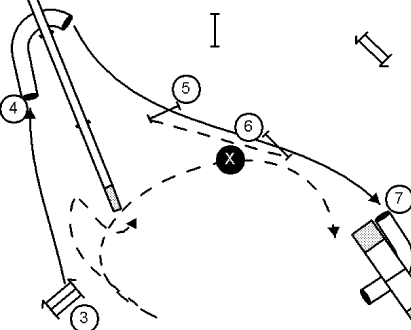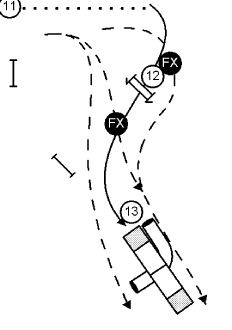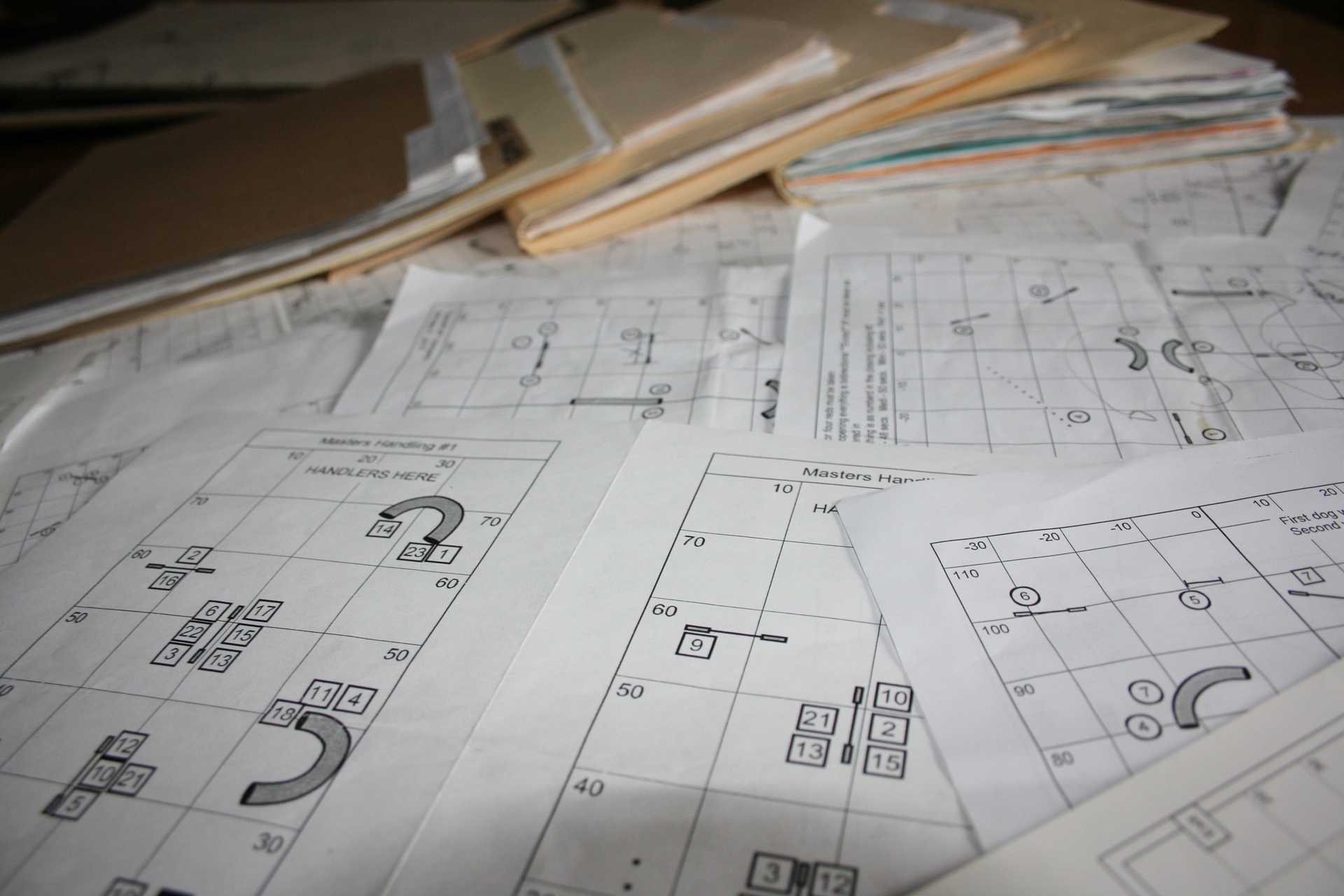Dana Pike Seminar Course 1 - May 31 2005
05 Jul 2005
I finally made some time to write up my notes on Dana Pike’s courses from her handling seminar over Memorial Day weekend.
She had two really challenging courses based on very similar equipment setups. Dana has graciously allowed me to present her courses here. I’ll post the other variation in the near future. If you have the opportunity, these are really great courses to work on, all handlers can get a lot out of them.
First a small disclaimer, I might not have the course layout exactly correct, I just scribbled the layout in my agility notebook. So if you give these courses a try, play around with tweaking the equipment a little to increase/decrease the challenges.
Take a look at this course and come up with your own handling strategy before I take a crack at discussing it.
Course Setup

The tunnel, wing jump, triple jump opening was handled either by a Lateral Lead Out or, for handlers running with their dogs, a Front Cross Learning the Front Cross - VideoFront Cross between jump 2 and the triple jump. The Lateral Lead Out was pretty straight forward for dogs with a good start line stay - they would be looking directly at the tunnel even though the handler was 15 feet offset from their line. The Lead Out or the Front Cross should be placed in the same location, at the X in the diagram shown below:
Opening Using a Lead Out or Front Cross

One of the biggest challenges on this course was the need to send your dog to the tunnel after the triple jump without the handler getting stuck behind the dog walk. This is one of those foundation skills that all our dogs need to have. By making the jump a triple Dana actually made this a little easier than if a single jump was used here. The dog would already be fully extended over the jump and land closer to the tunnel than if a single jump were used here. With a few practice tries and handlers remembering to not start moving away from their dogs until their dogs were committed to going to the tunnel all the teams were successful.
The motivating reason for not wanting to be behind the Dog Walk was the need to pick up your dog coming out of the tunnel and directing through jumps 5 and 6 and into the tunnel. This is definitely a case where noticing that 5-6-7 are almost on a straight line helps the handler. The most efficient handling was to get to the “X” far enough ahead of your dog to pick the dog up on your extended left arm. Then bring the left arm forward as you and the dog move forward and turn slightly towards the tunnel. This handling is identical to handling the second and third jumps of a Serpentine Serpentine Handling TechniquesSerpentine Sequence when handling from the same side of the Serpentine jumps. This is shown below:
Sending and Handling as a Straight Line

Coming out of the tunnel the dog sees wing jump 8 and past jump 8 the tunnel opening calls to the dog :^). The challenge of this part of the course is to have the handler push the dog enough to get over jump 8 but not so much as to queue the tunnel. So this is a case where Dana stressed using deceleration of the handler to cue the dog to collect as they approached the jump - you don’t want the dog to jump long over the jump; it only increases their path (and risks an off course). It is also possible for the handler to push on the dog’s line a little to insure the dog is on a right Lead prior to the jump; making for a tighter turn towards the dog walk (a wide turn opens the possibility for the triple as an off course).
Once the dog is committed to jump 8 the handler can run hard to the Dog Walk. This is sometimes called “pulling on the dog’s line”; you want the dog to turn tightly towards the dog walk. The thinking is by increasing the distance from your dog it increases the dog’s desire to chase you - as they come towards you they will take the shortest and fastest path to get to you. This also helps keep the dog from even considering the off course triple jump as they turn.
Handlers baby sitting the Dog Walk contact took jump 10 with the dog on their right and Rear Crossed the weave pole entry. Handlers with good Dog Walk distance and contacts could go so far as to layer jump 5 and pick their dogs up their left arm on the landing side of jump 10.
The approach to the A Frame was handled by either Front Crossing on the take off or landing side of the Double Jump - the goal being for the handler to be on the tunnel side of the A Frame and take the tunnel out of the dog’s path/view. Dana pointed out that handlers shouldn’t be afraid to Rear Cross spread jumps. Yet another approach for handlers was to “scoop” their dogs on the landing of the double jump (run with the dog on the handler’s left from the landing of the double all the way up the A Frame). Scooping wasn’t really an option for the fast dog handlers unless they could be sure their dogs would stay in the weaves as the handler cut hard towards the A Frame. These approaches are shown below:
Approaching the A Frame

Coming from the A Frame the only sensible path for the dog would be to turn to their right after jump 14. To accomplish this handlers who took the A Frame with their dogs on their right either Front Crossed at the bottom of the A Frame or Rear Crossed on the approach to jump 14. In general, the Front Cross seemed to give a little tighter turn than the Rear Cross. Handlers with the A Frame on their left could just push their dogs over the jump and turn to the teeter.
But after jump 14 the handling question to be answered was: “What side of the teeter do you want/need to be on?“. This was a case where the required handling for a specific part of the course impacted the handling of obstacles preceding it (including all the way prior to the A Frame when the handler chose on which side to handle the A Frame).
Closing Sequence

Handling the teeter on the handler’s right had the advantage of making the tunnel entrance less obvious but allowed the dog to think about the triple jump, kept the wings of jump 16 from interfering with the handler’s path, and allowed the handler to baby sit the teeter contact if necessary. Handling the teeter on the handler’s left meant the handler needed lateral distance from the teeter to avoid the wings of jump 16, made the tire the more obvious next obstacle and took the triple jump out of play. Yet another approach would be to start the teeter on the handler’s left and Front Cross at the downside of the teeter prior to jump 16.
Handling with the teeter on the handler’s right was popular among those of us working our dog’s contacts. But was was really surprising was dogs cutting right across their handler’s path and taking the tunnel. This was one of those moments where Dana’s advice that you don’t want your dog to ever cut across your path unbidden really showed its value. If you dog would cut you off at the knees you needed to be ahead of your dog after jump 16 so you could pull on its line to the tire. Handler’s with “flipper arms” or who stepped into their dog’s path were able to push their dogs over the triple instead of the tire.
I think the most successful handling was with the teeter on the left if the handler could maintain lateral distance from the dog on the teeter. Then it was just a straight line run to the tire. Handler’s who had to step to their right to get around the wing jump risked pulling their dog right towards the triple. The dog’s tendency to curl towards the handler helped keep Handler Focus and kept the dogs out of the tunnel. Either way the handler really had to drive and commit to the tire and not give any erroneous signals that would push the dog off course.
This was just a great course to run. Dana had us all walk the course and run it without any input. She then broke it down into four or five segments, discussed each and had us work on each section trying some of the handling approaches I discussed above. Her experience competing with large and small dogs was invaluable in helping each team improve their performance. When it came time to run the whole thing again at the end it was fun to feel completely confident in your execution.
I strongly recommend you setup and give this training course a try!
If you enjoyed this article won't you please:  Thanks!
Thanks!
